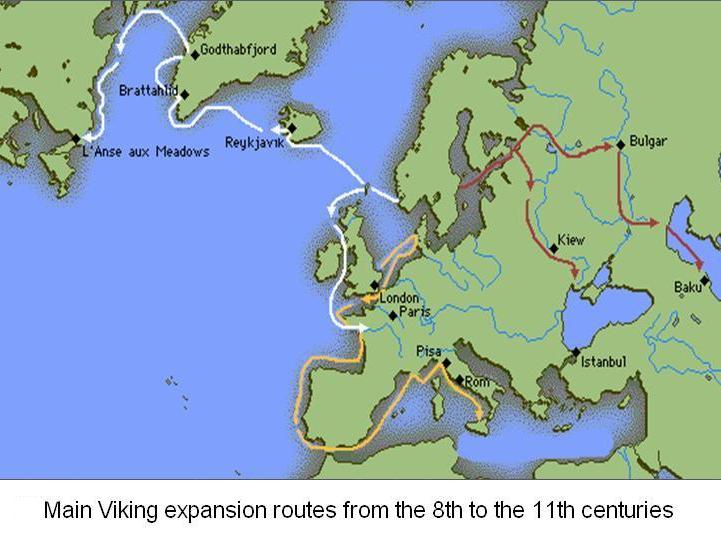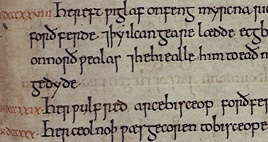
- •Table of contents
- •Part One. Section 1. History of language as a science.
- •Additional reading… Language and Speech
- •Major language families
- •The Indo-European family
- •Individual groups of Indo-European
- •Section 2 Germanic languages.
- •Picture 2. The Germanic languages. (Source: http://www.Answers.Com/topic/germanic-languages)
- •Old English / Anglo-Saxon (Englisc)
- •Anglo-Saxon Futhorc
- •Old English alphabet
- •Section 3. Old English.
- •Source: www.Uni-essen.De
- •Picture 8. Source: www.Uni-due.De Anglo-Saxon Chronicle
- •Prologue from Beowulf
- •Modern English version
- •Section 4. Old English Grammar.
- •Table 9
- •Table 10
- •Table 11
- •Reflexes of older words
- •Section 5. Middle English.
- •The Norman Invasion.
- •The Early Middle Ages (1066-1300)
- •An Extract from the Late Middle English works criticizing the Church
- •Compensation for the loss of inflections
- •Section 6. Early New English. Me and ene grammar.
- •And vowel digraphs:
- •Education in medieval times
- •The rise of prescriptivism
- •Writing of grammars
- •Grammars written by women
- •Elocution
Source: www.Uni-essen.De
The Scandinavian Invasion.
The flowering of English monastic culture was to come to an abrupt end because of political and military developments in Scandinavia. In the 8th century the Scandinavians became expansionist and began raiding neighbouring coasts. Initially this was simple marauding, plundering of places of wealth (usually seats of chieftains) and returning back to home base. With time they became more adventurous and, with the efficient and sea-worthy boats which they had, succeeded in making the crossing over the North Sea to Scotland. This was a qualitative change which was to have lasting consequences for the peoples of the British Isles. From this point onwards the Scandinavians are known as Vikings, a term deriving either from Frisian wic ‘settlement’ or Old Norse vik ‘bay’. The earliest attacks were on Lindisfarne and Jarrow in 793-4. Here it were the monasteries with their ornamental riches which attracted the raiders. They plundered and killed indiscriminately there and elsewhere, e.g. on the island of Iona, a centre of Hiberno-Scottish culture. Very soon the Vikings became the scourge of Ireland and the entire north of England.
Source: www.uni-due.de

Picture 8. Source: www.Uni-due.De Anglo-Saxon Chronicle

In contrast to the dramatic and vivid poetry of Beowulf, this Old English text is an official, factual document. It is a kind of year-by-year history of England, and is the earliest known history of England to have been written in the English language. It is thought to have been commissioned by King Alfred (848/9 to 899), after which it was sent to monasteries throughout the land. The Chronicle begins with the birth of Christ and, in most versions, the entries cease soon after the Norman Conquest in 1066. However, one version continued until as late as 1154.
The following passage from the Chronicle refers to the Battle of Hastings: 'Then Count William came from Normandy to Pevensey on Michaelmas eve, and as soon as they were able to move on they built a castle at Hastings. King Harold was informed of this and he assembled a large army and came against him at the hoary apple tree. And William came against him by surprise before his army was drawn up in battle array. But the king nevertheless fought hard against him, with the men who were willing to support him, and there were heavy casualties on both sides. Then King Harold was killed, and Earl Leofwine his brother, and Earl Grythe his brother, and many good men, and the French remained masters of the field...' Old English was the language of the Anglo Saxons, but following the Norman Invasion, French would become the language of power.
Eight manuscripts of the Chronicle have survived, of which six are in the British Library. This manuscript formerly belonged to Abingdon Abbey - it gives local information about Abingdon, strongly suggesting that it was also written there. It was written in about 1046 and contains additions to 1066. The page shown above contains entries for the years 824 to 833.
Source: www.bl.uk
